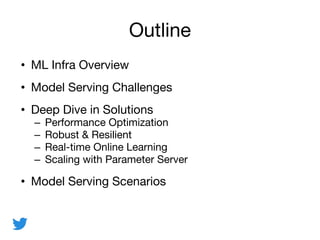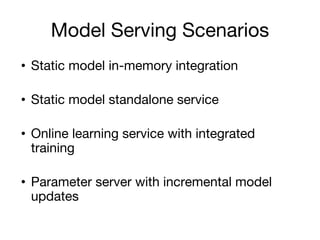ML Model Serving at Twitter
- 1. ML Model Serving @Twitter Joe Xie, Yue Lu and Jack Guo Twitter: @Joe_Xie, @Yue, @JackGuo8
- 2. Outline • ML Infra Overview • Model Serving Challenges • Deep Dive in Solutions – Performance Optimization – Robust & Resilient – Real-time Online Learning – Scaling with Parameter Server • Model Serving Scenarios
- 3. ML Infra - Overview • ML is increasingly at the core of everything we build at Twitter • ML infra supports many product teams – ads ranking, ads targeting, timeline ranking, product safety, recommendation, moments ranking, trends
- 4. ML Infra – Product Examples Ad Recap
- 5. ML Infra - High-level Architecture
- 6. ML Infra – Core Prediction Engine • Large scale online SGD learning • Architecture – Transform: MDL, Decision tree – Feature crossing – Logistic Regression: In-house JVM learner or Vowpal Wabbit
- 7. Model Serving Challenges • Performant: Trillions of predictions served daily • Robust & Resilient: Traffic spike during events, etc. Super bowl, Oscar award, world cup • Real-time: news, events, trends, hash tags, ads. Dynamically adapt to changes spanning as short as a few hours even minutes • Scalability: Horizontal scaling to handle organic growth, new features and advanced modeling
- 8. Performant – Prediction Engine Optimization • Reduce serialization cost – Model collocation – Batch request API • Reduce compute cost – Feature id instead of string name – Transform sharing across models – Feature cross done on the fly
- 9. Robust & Resilient • Resilient – Load factor to control the traffic based on the success rate of the requests • Robust – Snapshot models at fixed interval – Abnormal traffic detection
- 10. Real time – Online Learning Training Traffic Client Read Requests Prediction Service Instance Model Training Traffic Training Traffic
- 11. Scaling – Challenges • Network fan-out: Each prediction service has to receive all training traffic • Limit to Training Traffic Size: Training throughput limited by the capacity of a single instance • Inefficient serving : A big portion of the resource is allocated for training
- 12. Scaling – Parameter Server • Incremental model updates instead of integrated training Training Traffic ‘Server Node’ Model Updates Serving GroupServer Group Client Read Requests Model Model ‘Worker Node’ Model Model Updates Model Updates
- 13. Model Serving Scenarios • Static model in-memory integration • Static model standalone service • Online learning service with integrated training • Parameter server with incremental model updates
- 14. Thank you














